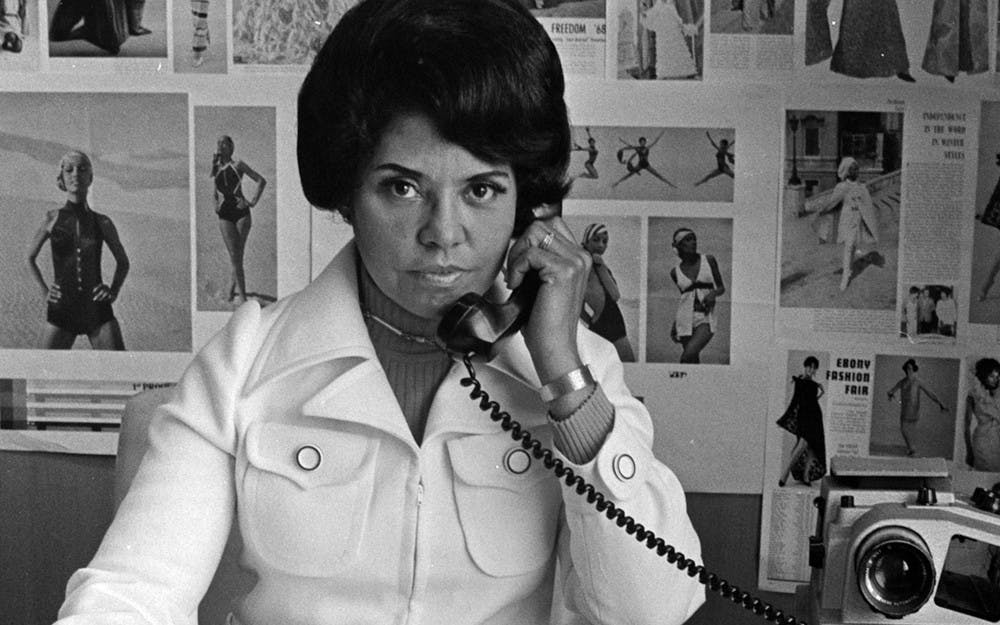In 1945, John H. Johnson founded the magazine Ebony and the fashion world underwent a massive change. The monthly publication — which featured predominantly black models, a rarity for the time — spawned the Ebony Fashion Fair, a traveling annual fashion show that showcased garments from top European designers and featured African-American models in breathtaking couture gowns. Although primarily a charitable endeavor, the Ebony Fashion Fair was also a platform for African-American women who had previously been shut out of modeling and acting jobs due to the Eurocentric, Twiggy-esque beauty standards held at the time.
Eunice Johnson, the creator and director of the show, effectively altered these standards by dressing her models in some of the most luxurious, gorgeous clothing of the day and challenging preconceived notions of black beauty. While the final show was held shortly before Johnson’s death in 2010, the legacy of the Ebony Fashion Fair endures due to its persisting relevance and the work done by alumni and admirers to preserve its influence. That influence will soon be available for the public to observe in the North Carolina Museum of Art’s latest exhibit, “Inspiring Beauty: 50 Years of Ebony Fashion Fair,” an in-depth exploration of the show’s storied history and a showcase of some of the fashion it brought to life on the catwalk.
“Ebony Fashion Fair was, in my opinion, about more than the beautiful clothing shown on the runways,” Precious Lovell, who will be in the NCMA galleries as a Designer-in-Residence during the exhibit’s run, wrote in an email. “It was about changing the way African-Americans saw themselves and how they were seen by others.”
Lovell is an artist and associate professor of the practice in Art + Design at N.C. State’s College of Design, as well as a fashion designer who worked for two decades in New York City’s Garment District. When asked what she hopes the community will gain from this exhibit, Lovell was quick to emphasize the contributions of Eunice Johnson and the positive legacy she left behind.
“Mrs. Eunice Johnson was a true visionary to whom is owed a huge debt of gratitude by the African American community and anyone of African descent who works in a fashion-related industry,” Lovell said. “What she and Ebony Fashion Fair did to highlight positive perceptions of Black people within and beyond the African-American community is something that should be acknowledged and applauded by all Americans!”
This sentiment was shared by Kimberly Kearse-Lane, a former Fashion Fair model who played a major role in securing media and content for the exhibition.
“[The show] started during times when African-American women weren’t seen in magazines or on stages,” Kearse-Lane said. “I like people to realize that because of the vision of the Johnsons, they were able to allow platforms for women of color — women of many different sizes, too — and get them to be seen on a larger stage, to dress up and develop an opinion, a glamorous opinion, about other types of people of both different color and size.”
Kearse-Lane’s story is a fascinating one that reflects the power of Ebony to inspire young girls of color.
“I’m a little girl from Topeka, Kansas, and I grew up in a town where there weren’t many women of color doing things like modeling,” Kearse-Lane said. “My mom wanted to make sure that I had the opportunity to see women who look like me, to see women who were dressed fabulously, so she would always take me to the Ebony fashion shows and then try to get me backstage to meet the models. I was always self-conscious about my dark skin and height, and she was always trying to put closer to models who looked like me.”
While the fashion world has become exponentially more diverse since the founding of Ebony and the first Ebony Fashion Fair show in 1958, stories like Kearse-Lane’s are still relatively common as young girls of color struggle to find representation in media that champions white beauty and continues to degrade black women. The exhibition keeps this struggle in mind, especially in the context of the current sociopolitical climate, which has fostered even greater racial tensions. When asked about how the exhibit will fit into that political context, Lovell had this wise statement to share, which perfectly encapsulates the relevance of the exhibit and the undiminished power of Ebony Fashion Fair:
“The current political climate in the U.S. is sadly reminiscent of the 1950s, when Ebony Fashion Fair had its beginnings,” Lovell said. “I feel that remembering the spirit of what Mrs. Johnson achieved with the shows is something the African-American community should embrace. Do for self. Believe in yourself. Don’t let anyone stop your forward movement. Stay focused on your goals. Remember that the playing field is not even, it never has been and it may never be. But don’t let that deter you. It didn’t deter our ancestors moving through the Dismal Swamp trying to disappear into freedom, and it shouldn’t deter us moving through the dismal swamp that is the current political climate.”
“Inspiring Beauty: 50 Years of Ebony Fashion Fair” runs Oct. 28 to Jan. 21, 2018 in the East Building of the North Carolina Museum of Art in Raleigh.
Get The Chronicle straight to your inbox
Signup for our weekly newsletter. Cancel at any time.

